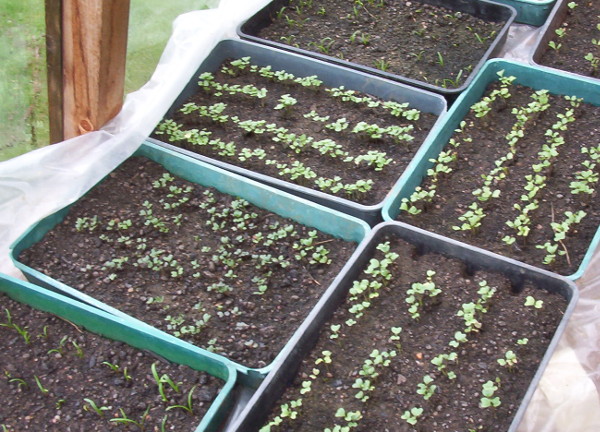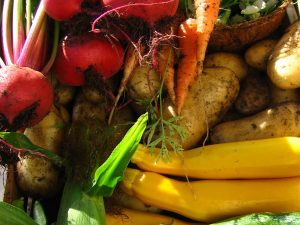March is the month when things really start to move in the growing season. In fact the start of the year used to be Lady Day, the Feast of the Annunciation, 25th March until 1752 in Britain when we adopted the Gregorian calendar and started our year on the 1st January. From an agricultural viewpoint, it would have made sense to have stuck with the old system, starting the year on the spring equinox, in link with the seasons.
Sowing & planting in March on the vegetable plot
If the weather is cold but otherwise reasonable, you can steal some time and start early by cloching and fleecing. Although expensive glass cloches have been around for many years, nowadays we can get cheap polythene tunnel cloches and even cheaper horticultural fleece. Place the cloche or fleece a week or two before planting and the soil will have warmed up nicely as well as being dry and easy to work.
Water well into the drill prior to sowing and replacing the cloche. Do remember to water weekly or more frequently in sunny weather under cloches.

First cloche set up on the plot for onions.
To hold down fleece without tearing, save plastic 2 litre milk containers and fill with sand or water although water tends to leak. The smooth surface will weigh down the fleece but not damage it. It’s surprising how just a layer of fleece can raise the temperature of the underlying soil.
Plant out your onion and shallot sets. If growing onions from seed started earlier in the year under cover these can also go out now. You can also direct sow onions, thinning to the eventual spacing. Cloching will help them establish and also stop pigeons from pulling them up.
March is the right time to establish an asparagus bed if you are starting from crowns. Do make sure you get it in the right position as it will be there permanently.
Mid March should let you start planting out those potatoes you’ve had chitting. If you want some really early potatoes, start some in a black polythene sack in the greenhouse or tunnel. Punch drainage holes in the sack and use a multi-purpose compost. See Guide to Growing Potatoes
Staying with root crops, you can plant Jerusalem artichoke tubers now. Be aware that getting them all up at harvest time is very difficult and any tubers left in the ground will grow, so effectively you’re creating a permanent bed.
Things to sow
- Beetroot
- Broad Beans
- Early Peas (but they may do best started in a gutter in the greenhouse then slipped into a trench or in seed trays)
- Brussels sprouts – early varieties like Peer Gynt will be ready in September
- Kohl Rabi
- Leeks
- Lettuce
- Radish
- Parsnips
- Spinach Beet
- Early Turnips

Comfrey coming back to life – the most useful herb you can grow. See Bocking 14 Comfrey.
Under cover
Windowsill or a propagator in the greenhouse will come into use now to start off your tomatoes, peppers, aubergines and cucumbers.
Many of the crops you can sow directly will also benefit from cloching, especially as you move northwards or started off in modules in a cool greenhouse or coldframe and then planted out later.
Fruit
Planting & pruning
There is still time to finish planting bare rooted fruit trees and bushes, especially raspberries and other cane fruits.
Early this month you can still prune apple and pear trees while they are still dormant. There is also time to prune gooseberries and currants. With currants shorten the sideshoots to just one bud and remove old stems from the centre of the bushes.
They’ll benefit from some compost spread around the base as well or some general purpose fertiliser like fish, blood & bone. Trees will appreciate some wood ash spreading under them.

The adults shelter in the sheds but the kids don’t care as they splash in the puddles on the allotment site.
Harvest
Any leeks left standing should come up now – you can freeze them for use in soups and stews or make concentrated leek & potato soup to freeze and thin out when used.
Parsnips too should come up in early March before they try and re-grow. They’ll store for a month or so in damp sand but the plant knows it is growing time again. If you turn them into a mash, perhaps with carrots, they’ll freeze well taking up little room
You may have spinach beet and chards available, the last of the late Brussels sprouts, winter cauliflowers, kale, swedes and scorzonera.
Don’t forget to keep checking the purple sprouting!
General jobs on the plot
Have a good tidy up and finish those odd construction jobs because you are going to be busier still later in the year!
Thanks to John Harrison of Allotment & Gardens for information.
You can get John’s book Vegetable Growing Month-by-Month here.


